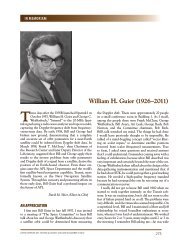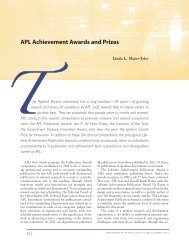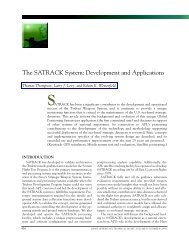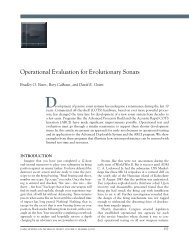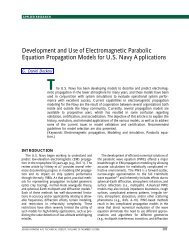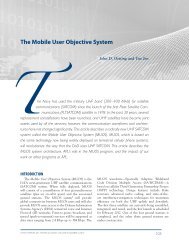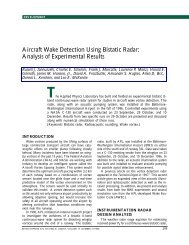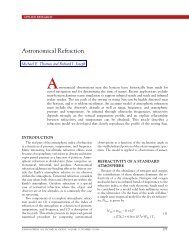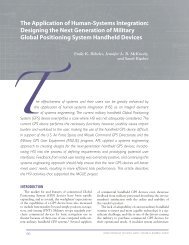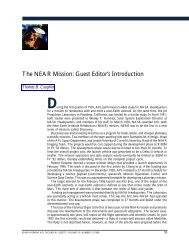A Practical Application of Relativity to Observation and Control of ...
A Practical Application of Relativity to Observation and Control of ...
A Practical Application of Relativity to Observation and Control of ...
Create successful ePaper yourself
Turn your PDF publications into a flip-book with our unique Google optimized e-Paper software.
S. B. COOPER<br />
OCXO frequency residual (ppb)<br />
35<br />
30<br />
25<br />
20<br />
15<br />
10<br />
5<br />
the extended mission that began on 18 March 2012.<br />
The results were somewhat surprising. The residuals<br />
(Fig. 10) again exhibited OCXO aging at a linear rate <strong>of</strong><br />
−0.0043 ppb/day, but the linear fit was <strong>of</strong>fset by almost<br />
−0.8 ppb from the earlier linear fit <strong>of</strong> cruise residuals<br />
(Fig. 7). Although it remains unclear, even after examination<br />
<strong>of</strong> additional data, whether the change in OCXO<br />
frequency was sudden or gradual, it appears likely that<br />
the increased OCXO temperature in orbit, shown in<br />
Fig. 10, accounts for at least part <strong>of</strong> the 0.8-ppb shift.<br />
CONCLUSIONS<br />
We’ve observed that the behavior <strong>of</strong> the MESSEN-<br />
GER precision oscilla<strong>to</strong>r, an OCXO, <strong>and</strong> the behavior<br />
<strong>of</strong> the clock driven by that oscilla<strong>to</strong>r are strongly<br />
influenced by relativistic effects due <strong>to</strong> the dynamics<br />
<strong>of</strong> the spacecraft trajec<strong>to</strong>ry. We successfully employed<br />
that observation <strong>to</strong> predict the future behavior <strong>of</strong> the<br />
onboard clock. The MESSENGER Mission Operations<br />
Team has incorporated that information in<strong>to</strong> routine<br />
operations in determining the parameters needed <strong>to</strong><br />
compute onboard G&C time. This has resulted in an<br />
The Author<br />
394<br />
Early cruise residuals<br />
On-orbit residuals<br />
88-day average OCXO-B temp.<br />
Fit <strong>to</strong> early cruise residuals<br />
Fit <strong>to</strong> on-orbit residuals<br />
Y = (–0.0043 ppb/day)X + 35.10 ppb<br />
Y = (–0.0043 ppb/day)X + 34.31 ppb<br />
OCXO-B temperature<br />
0 0<br />
0 500 1000 1500 2000 2500 3000<br />
Days since launch<br />
Figure 10. OCXO-B fractional frequency residuals for last 5 years <strong>of</strong> the MESSENGER primary<br />
mission, after correction for relativistic effects, using orbit determination solution OD260.<br />
improvement in opera<strong>to</strong>r control<br />
<strong>of</strong> the error in G&C time.<br />
It was also determined, using<br />
knowledge <strong>of</strong> these relativistic<br />
effects, that the OCXO ages<br />
approximately linearly when the<br />
average oscilla<strong>to</strong>r temperature is<br />
fairly steady <strong>and</strong> that a linear fit<br />
<strong>to</strong> TDTRATE residuals provides a<br />
good prediction <strong>of</strong> future oscilla<strong>to</strong>r<br />
<strong>and</strong> onboard clock behavior.<br />
ACKNOWLEDGMENTS: I am grateful <strong>to</strong><br />
the entire MESSENGER team for its<br />
support <strong>of</strong> the definition, development,<br />
<strong>and</strong> operation <strong>of</strong> the mission<br />
timekeeping system. The performance<br />
<strong>of</strong> this very accurate timekeeping<br />
system has made possible<br />
the observations described in this article. Jack Ercol <strong>and</strong><br />
Allan Holtzman provided the oscilla<strong>to</strong>r temperature data<br />
used in this discussion. James Hudson <strong>and</strong> Edwin Colwell<br />
have h<strong>and</strong>led the day-<strong>to</strong>-day operation <strong>of</strong> the timekeeping<br />
system <strong>and</strong> have embraced this new approach<br />
<strong>of</strong> using predictions <strong>of</strong> relativity <strong>to</strong> control the error in<br />
onboard G&C time. The MESSENGER Trajec<strong>to</strong>ry Database<br />
developed by James McAdams was used extensively<br />
<strong>to</strong> obtain the spacecraft velocity <strong>and</strong> ranges needed <strong>to</strong><br />
compute the relativistic effects described. I’ve particularly<br />
enjoyed occasional chats with Robert Henderson about<br />
relativity <strong>and</strong> how it should be applied <strong>to</strong> this complex<br />
mission. Finally, I am indebted <strong>to</strong> Robert Jensen for his<br />
guidance on how <strong>to</strong> compute the relativistic effects <strong>of</strong><br />
velocity <strong>and</strong> gravity on oscilla<strong>to</strong>r behavior.<br />
REFERENCES<br />
1 Cooper, S. B., “From Mercury <strong>to</strong> Plu<strong>to</strong>: A Common Approach <strong>to</strong> Mission<br />
Timekeeping,” IEEE Aerosp. Electron. Syst. Mag. 21(10), 18–23 (2006).<br />
2 Hudson, J. F., <strong>and</strong> Colwell, E. J., “Spacecraft Clock Maintenance for<br />
MESSENGER Operations,” in Proc. AIAA SPACE 2011 Conf. <strong>and</strong><br />
Exposition, Long Beach, CA, paper AIAA 2011-7183.<br />
3 Parkinson, B. W., <strong>and</strong> Spilker, J. J. Jr. (eds.), Global Positioning System:<br />
Theory <strong>and</strong> <strong>Application</strong>s, Vol. 1, American Institute <strong>of</strong> Aeronautics &<br />
Astronautics, Inc., pp. 678–679 (1996).<br />
Stanley B. Cooper is an electrical engineer in the Space Department’s Mission Design, Guidance <strong>and</strong> <strong>Control</strong> Group<br />
(SEG) <strong>and</strong> is a member <strong>of</strong> the Senior Pr<strong>of</strong>essional Staff. For the past decade, he has been responsible for the mission timekeeping<br />
systems for a variety <strong>of</strong> space missions. He previously designed flight <strong>and</strong> ground electronics <strong>and</strong> ground s<strong>of</strong>tware<br />
for a variety <strong>of</strong> APL projects for spacecraft, shipboard, <strong>and</strong> labora<strong>to</strong>ry use. His e-mail address is stanley.b.cooper@jhuapl.edu.<br />
The Johns Hopkins APL Technical Digest can be accessed electronically at www.jhuapl.edu/techdigest.<br />
70<br />
60<br />
50<br />
40<br />
30<br />
20<br />
10<br />
OCXO temperature (ºC)<br />
JOHNS HOPKINS APL TECHNICAL DIGEST, VOLUME 32, NUMBER 1 (2013)





